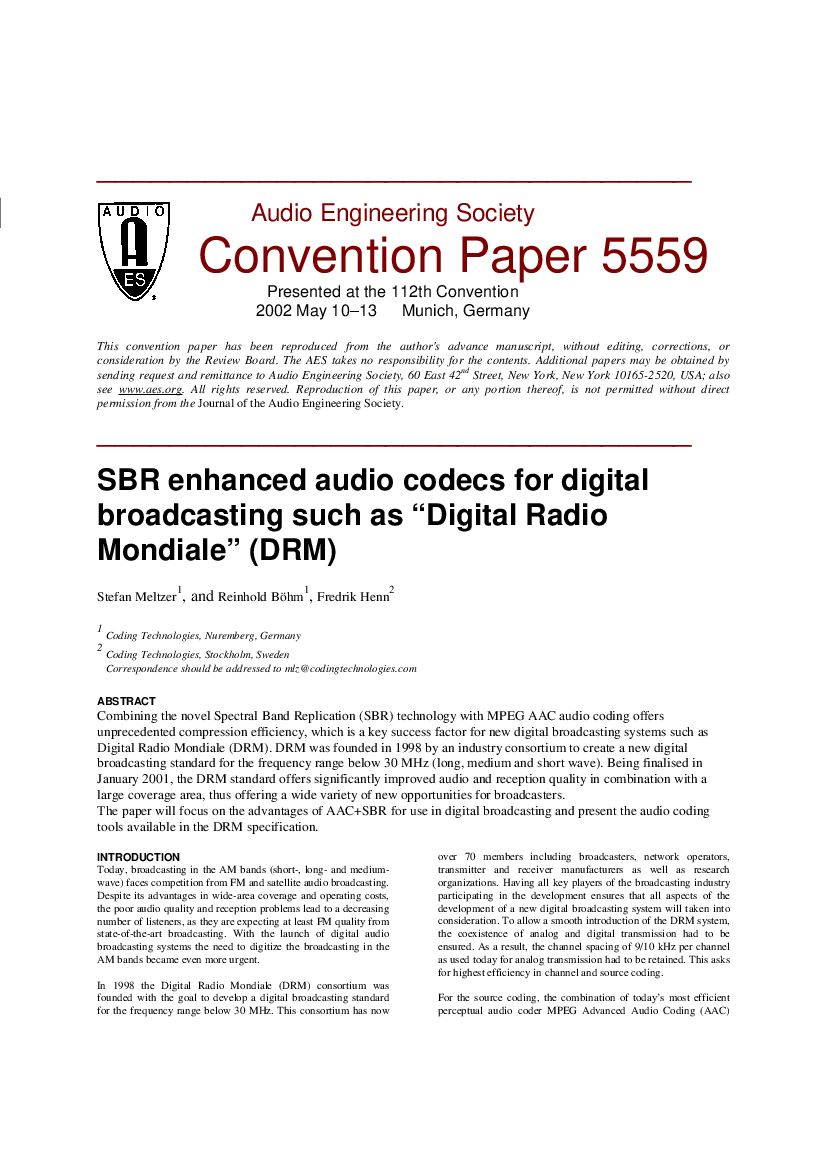Home / Publications / E-library page
You are currently logged in as an
Institutional Subscriber.
If you would like to logout,
please click on the button below.
Home / Publications / E-library page
Only AES members and Institutional Journal Subscribers can download
Combining the novel SBR technology (Spectral Band Replication) with MPEG AAC audio coding results in the most powerful audio codec available today. It`s unprecedented compression efficiency is a key success factor for new emerging digital broadcasting systems such as Digital Radio Mondiale (DRM). DRM is a industry consortium that has been founded in 1998 to create a new digital broadcasting standard for the frequencies below 30 MHz (long, medium and short wave). Being finalised in January 2001 and recommended by ITU, the DRM standard offers significantly improved audio and receiption quality in combination with a large coverage area, thus offering a wide variety of new opportunities for broadcasters. In spite of being limited in bitrate due to the requirement to keep the existing 9/10kHz channel spacing in those frequency bands, DRM is able to offer very high audio quality by using SBR-enhanced MPEG AAC audio coding. The paper will focus on the advantages of AAC+SBR for use in digital broadcasting, describe the DRM system as a whole and talk in more detail about the audio coding tools available in the DRM specification.
Author (s): Meltzer, Stefan; Bohm, Reinhold; Henn, Fredrik
Affiliation:
Coding Technologies, Nuremberg, Germany ; Coding Technologies, Stockholm, Sweden
(See document for exact affiliation information.)
AES Convention: 112
Paper Number:5559
Publication Date:
2002-04-06
Import into BibTeX
Session subject:
Low Bit-Rate Audio Coding
Permalink: https://aes2.org/publications/elibrary-page/?id=11327
(150KB)
Click to purchase paper as a non-member or login as an AES member. If your company or school subscribes to the E-Library then switch to the institutional version. If you are not an AES member Join the AES. If you need to check your member status, login to the Member Portal.

Meltzer, Stefan; Bohm, Reinhold; Henn, Fredrik; 2002; SBR Enhanced Audio Codecs for Digital Broadcasting Such as "Digital Radio Mondiale" (DRM) [PDF]; Coding Technologies, Nuremberg, Germany ; Coding Technologies, Stockholm, Sweden; Paper 5559; Available from: https://aes2.org/publications/elibrary-page/?id=11327
Meltzer, Stefan; Bohm, Reinhold; Henn, Fredrik; SBR Enhanced Audio Codecs for Digital Broadcasting Such as "Digital Radio Mondiale" (DRM) [PDF]; Coding Technologies, Nuremberg, Germany ; Coding Technologies, Stockholm, Sweden; Paper 5559; 2002 Available: https://aes2.org/publications/elibrary-page/?id=11327